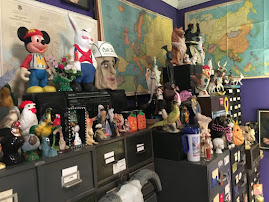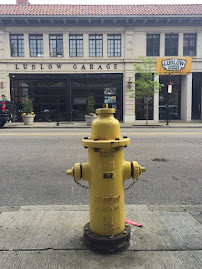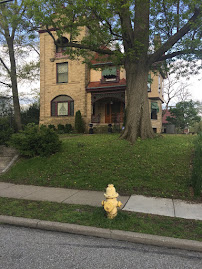
Marshall Burns Lloyd (1858-1927)
Dear George,
Lately I've been delving into the history of my hometown, Menominee, Michigan. There are lots of stories. One of the most fascinating concerns inventor and local businessman, Marshall Burns Lloyd. Lloyd, of course, is a familiar name to anybody who grew up in Menominee. My siblings and I were all born in what came to be named St. Joseph Lloyd Hospital. We spent our Saturday afternoons at children’s matinees at the Lloyd Theater, and my mother would take us to buy clothes at the department store in the basement of the Lloyd Building. Many of my friends' parents worked for the Lloyd Factory. Despite all this, I can’t recall knowing anything about Marshall B. Lloyd. Recently I discovered a goldmine of information on the Internet (see especially the "Marshall Burns Lloyd Photo Gallery" at www.mlloyd.org). It’s quite a story.
Marshall Burns Lloyd was born in St. Paul, Minnesota, on March 10, 1858, the son of Margaret Lloyd and Welsh emigree John Lloyd. When he was just a baby, his parents returned to Canada and settled on a farm near the little village of Meaford on Georgian Bay. Financial difficulties forced Marshall to leave school at age 14 to help his father in a shingle mill. He then worked as a grocery clerk, but gave this up to sell fish, catching his merchandise in the Georgian Bay and peddling them door to door from a wheelbarrow. Lloyd's first invention as a teenager was a new and effective fish spear.
At age 16, with an offer of $8 a month plus room and board, Lloyd left Meaford for Toronto and worked in a grocery store. He used his meager savings to buy a stock of soap which he peddled door to door. He told an interviewer, "I guess the women felt sorry for me because I was so small...They bought enough soap to last them a long, long while." When he’d satiated the soap market in Toronto, he expanded his business to cheap jewelry, using one of his soap boxes to stand on and hawk his wares on Yonge Street. Lloyd then drove about the Canadian countryside, selling general merchandise to farmers from a covered wagon drawn by a horse. At eighteen he became a rural mail-carrier, driving a six-dog train and sleigh on the two-day, 65-mile route between Port Arthur and Pidgeon River.
Attracted by the rush of settlers to Winnepeg, Lloyd worked as a waiter while engaging in real-estate speculation and accumulated $15,000 in a few months. He bought a farm at Grafton, North Dakota, where he brought his family. However, Lloyd didn't take to farming and soon turned to the insurance business in St. Thomas. While doing so, he patented a revolutionary weighing scale for use by farmers. As he attempted to manufacture the scale in a blacksmith shop, the uninsured building was destroyed by fire, and Lloyd lost everything.
Hopeful of rebuilding his plant, Lloyd went to Minneapolis, but couldn't secure financial aid and became a shoe salesman, working on other inventions in his spare time. After 10 years the C. O. White Manufacturing Co. of Minneapolis gave him an interest in the company in exchange for the right to use his invention for weaving wire door and table mats. Another of his inventions for weaving woven-wire bed springs revolutionized the bed-spring industry, and Lloyd was able to buy the White company, renaming it the Lloyd Manufacturing Company. He sold manufacturing rights to businesses in Europe, Australia, New Zealand, and South Africa, and by 1900 Lloyd was a wealthy and successful self-made man.
Lloyd next perfected a machine to make wire wheels for baby carriages which made the ride much smoother. He had difficulty getting Minneapolis financiers to extend him more credit, and he began looking for opportunities elsewhere. Lumbermen John W. Wells, Augustus Spies, and others in Menominee, faced with the decline of the lumbering industry and the closing of sawmills, were seeking new industries, and Marshall Lloyd contacted them. Lloyd sold his Minneapolis plant in 1906, began building in Menominee, and in 1907 transferred his machinery and other assets to a new Lloyd Manufacturing Company with a capitalization of $400,000 and a 77,000 square foot building on Green Bay from his Menominee backers. His business associates were Frank A. Spies, John W. Wells, W. S. Carpenter, John Henes, Leo C. Harmon, and John M. Thompson. Lloyd brought with him two "lieutenants" from Minneapolis -- Lewis Larsen, who shared his interest in inventing, and Christ Mathisen, a skilled workman.

Lloyd Manufacturing Co., Menominee, Mich.
The Lloyd company's payroll in the first year was $45,000, and sales were $129,032. Early days of the company were difficult, and, as financial problems mounted, the directors tried to buy Lloyd out, an option he refused. At one point Lloyd sold his watch as part of his effort to meet payroll, and another longtime employee withdrew her entire savings to help buy materials for the plant. Several directors placed their stock on the market at a substantial loss, and Lloyd offered it as a stock option to his executives and foreman. J. W. Wells and F. A. Spies, bought the remainder of the stock which later increased sixteen times in value.
The Lloyd Manufacturing Co. first made express wagons, then collapsible go-cars. With financial support from John Wells, Lloyd invented a new method of making thin-gauged steel tubing in 1910, selling the patents for $800,000. Lloyd resumed making hand-woven reed baby carriages in 1914. At the Lloyd plant he changed the traditional method of weaving, finding a way to weave the wicker independently of the frame and attaching it afterwards. He then devised the Lloyd Loom to weave wicker in this new way. It revolutionized the wicker-manufacturing industry. While it took an expert weaver nine hours to weave the wicker for a baby carriage, it could be done with the Lloyd Loom in 18 minutes. One loom did the work of thirty weavers and resulted in a 600% increase in the plant’s output.

Shaped and power flat looms, Lloyd Manufacturing Co.

Lloyd Loom baby carriages
The Lloyd plant employed 1500 Menominee area workers and supplied demand for Lloyd Loom baby carriages throughout the world. The fabric made at Lloyd was used, not only in baby carriages, but a large variety of furniture. Lloyd sold his patent to an English manufacturer who used it to create a collection of over 600 designs of English furniture, and the Lloyd Loom soon became the rage in Europe. At its peak of popularity in the Art Deco period of the 1930's, Lloyd Loom furniture could be widely found in restaurants, tea rooms, hotel lobbies and rooms, and the royal boxes at Wimbledon, as well as aboard cruise ships, ocean-going liners, and even a zeppelin. One of the more novel products was an extra-wide wicker chair that British Spitfire pilots in their bulky flying suits used to rest up between missions in World War II. When the Germans were unable to vanquish the Spitfires, they took revenge near the end of the war by bombing the British Lloyd Loom factory. With the factory’s destruction, the manufacture of Lloyd Loom chairs ended in Europe, not to resume until 1985 with a new factory in Spalding. During the Second World War 250 Lloyd employees in Menominee entered the military, and women replaced men in the factory. Eighty-five percent of the company's work was in war production: glider fuselages, bomber trainers, airplane motor mounts, and 100,000 75 mm. high-explosive shells per month.

Lloyd Loom wicker furniture
With his wealth running into millions of dollars by the 1920’s, Lloyd maintained a beautiful winter home in Miami and built an experimental factory near his home on Sheridan Road in Menominee. Wanting to aid Menominee’s workforce, Lloyd designed and patented a sectional house with a special insulation for the cold that he invented and a highly economical heating system. Lloyd maintained a crew of a dozen men to work on his plan and purchased the old county fair grounds in Menominee as a site for his planned "model city." Unfortunately illness interfered with and eventually derailed his plans.
In February 1924 Menominee's only department store was destroyed by fire, and the owners decided not to rebuild. With the business district markedly depressed as a consequence, a committee of citizens appealed to Lloyd, and he decided to help finance a new community cooperative department store and theater enterprise. Under his leadership, 1500 residents subscribed to more than $500,000 in the new Community Building corporation. Finding difficulty in obtaining a tenant, Lloyd leased the building himself. Travelling to England, France, and Germany to establish buying connections, Lloyd stocked the store to rival department stores in major cities. Originally labelled "The Wonder Store," Lloyd's dream retail outlet included an arcade and the Lloyd Theater, equipped to be the equal of any in the state. The theater and store opened in October, 1926, with a huge community celebration, and they were soon drawing patrons from distant towns and cities. Originally built as a silent theater, the Lloyd became the third theater north of Chicago to show "talkies".

The Lloyd Department Store, Sheridan Road, Menominee
Lloyd was elected Mayor of the Menominee for two terms from 1913 to 1917. He invented so many improvements for Menominee's government that he was known as "Efficiency" Lloyd, a nickname that stuck permanently. During this period the city took over the water works, previously operated by a private company, and Lloyd was particularly proud that the city, which previously had had a high typhoid rate, was assured of a permanent supply of pure water. Lloyd was a member of Menominee’s Rotary Club and Chamber of Commerce, as well as the Knights of Pythias.
Lloyd's father had died of an illness which had been incorrectly diagnosed and treated. Because small town practitioners lacked the laboratory equipment and resources available to surgeons in big cities, Lloyd made a decision to bring the latest in scientific techniques to Menominee physicians. He placed the major portion of his estate, $2,000,000, in a trust fund to endow a diagnostic clinic and provide care for local people who couldn't otherwise afford it. The local hospital was renamed St. Joseph-Lloyd Hospital in his honor, though this took years because of legal complications.

St. Joseph Lloyd Hospital, Menominee
Lloyd was president of the Lumbermen's National bank, president of the Community Building Co., president and owner of the Lloyd Department Store and the Lloyd Theater, director of the Heywood-Wakefield Co., vice-president of the Automatic Seamless Tubing Co., and director of the Hoskin-Morainville Paper Co. He was an expert skater, an ardent motorist and golfer, and had a great appreciation of poetry.
In 1922 Lloyd married his third wife, Mrs. Henriette Pollen of Orange, New Jersey. They had met in Florida where Lloyd was spending the winter. She was working in a novelty shop, and, according to Lloyd in an interview, "her manner in waiting on him immediately won his interest." Lloyd did not have children throughout his life.
Marshall Burns Lloyd died of a heart attack at 4:15 a.m. on August 10, 1927. He had sat up in his bed, saying "I want to take a deep breath," then collapsed. His wife, brother, nephews, close friend, and attending physicians were present, including our family doctor, Dr. Sethney. The Mayor of Menominee later wrote, "Seldom does a community so feel the loss in case of the death of an individual as is felt in the passing of Mr. Lloyd. He was more than an individual. He represented the spirit of progress, civic improvement and prosperity in these Twin cities." My grandfather, V.A.L. Sr., was quoted in the Herald-Leader as saying: "I shall always remember his expressions of explicit faith in Menominee and his love for its citizens. We have suffered the irreparable loss of a leader and a friend."
Love,
Dave
SOURCES:
“Biographies,” Marshall Burns Lloyd (http://mlloyd.org/gen/lloyd/mblphoto.htm)
"Contemporary Design Profile: Marshall Burns Lloyd") (http://siera-macpherson.com)
"Lloyd Loom." (www.classicandperformancecar.com)
“Marshall Burns Lloyd Photo Gallery” (http://mlloyd.org/gen/lloyd/mblphoto.htm)
“Obituary and articles,” Marshall B. Lloyd (http://mlloyd.org/gen/lloyd/mblphoto.htm)
G-mail Comments
-Phyllis S-S (1-28): Dave, This was fascinating. Thanks. Did you find all those citations on line? I didn't know you could obtain books... pss
-Gayle C-L (1-26); David, Such a great story. He was a true visionary and a great man. And he married a woman from New Jersey. ;))))))))))) Thx for the story. Lol. G
-JML (1-24): That's fantastic. Reading this (i.e., separate e-mail) and your piece on Mr Lloyd, I tend to believe that people of that time were made of different stuff than in later generations.














































































































































































